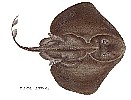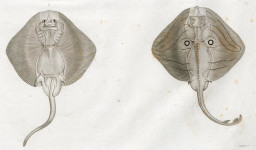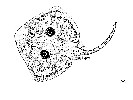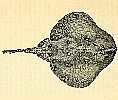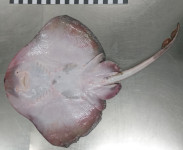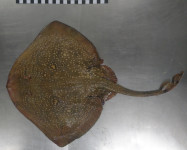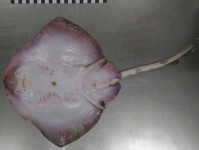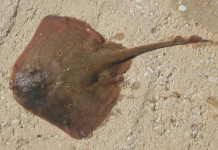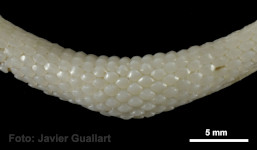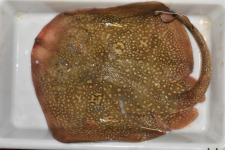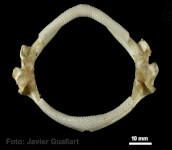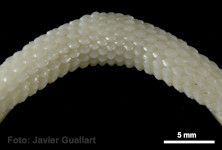Raja radula
Delaroche, 1809
Rough ray
Classification: Elasmobranchii Rajiformes Rajidae
Reference of the original description
Suite du mémoire sur les espèces de poissons observées à Iviça. Observations sur quelques-uns des poissons indiqués dans le précédent tableau et descriptions des espèces nouvelles ou peu connues. Annales du Muséum d'Histoire Naturelle, Paris, 13, 313–361
Suite du mémoire sur les espèces de poissons observées à Iviça. Observations sur quelques-uns des poissons indiqués dans le précédent tableau et descriptions des espèces nouvelles ou peu connues. Annales du Muséum d'Histoire Naturelle, Paris, 13, 313–361
Synonyms / new combinations and misspellings
Batis radula, Raia radula, Raia virgata, Raja atra, Raja cf. radula, Raja (Raja) radula
Batis radula, Raia radula, Raia virgata, Raja atra, Raja cf. radula, Raja (Raja) radula
Description :
Citation: Raja radula Delaroche, 1809: In: Database of modern sharks, rays and chimaeras, www.shark-references.com, World Wide Web electronic publication, Version 01/2026
Please send your images of "Raja radula" to info@shark-references.com
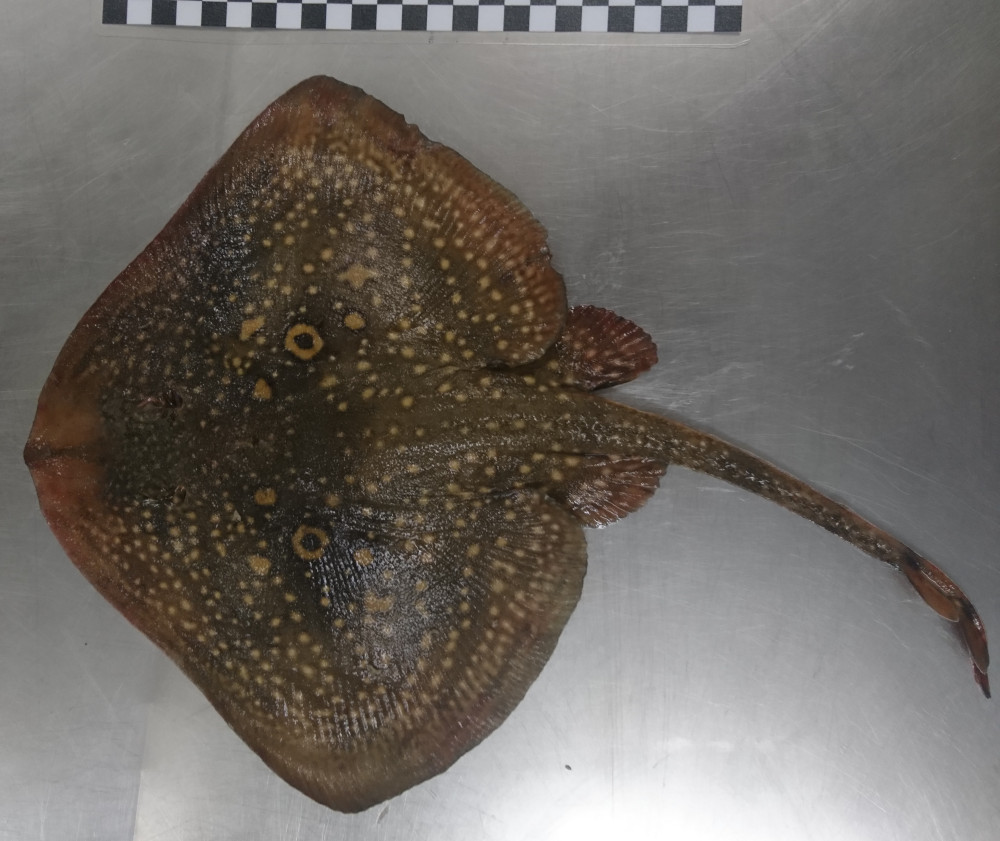
Raja radula Delaroche, 1809, adult male, 44, 20 TL, caught in València, 21.09.2017 © Jaime Penadés-Suay, Associació LAMNA, facebook Associació LAMNA, València (Spain)

Raja radula Delaroche, 1809, adult male, 44, 20 TL, caught in València, 21.09.2017 © Jaime Penadés-Suay, Associació LAMNA, facebook Associació LAMNA, València (Spain)
Common names
 Rauer Rochen,
Rauer Rochen,  Raurochen,
Raurochen,  Raya áspera,
Raya áspera,  Raie râpe,
Raie râpe,  Rough ray,
Rough ray,  Rough skate,
Rough skate,  Picara spinosa,
Picara spinosa,  Picara tunna,
Picara tunna,  Pichira magnusa,
Pichira magnusa,  Pichira spinusa,
Pichira spinusa,  Rasa,
Rasa,  Rasa spinosa,
Rasa spinosa,  Raspo,
Raspo,  Razza scuffina,
Razza scuffina,  Raia-áspersa
Raia-áspersa
 Rauer Rochen,
Rauer Rochen,  Raurochen,
Raurochen,  Raya áspera,
Raya áspera,  Raie râpe,
Raie râpe,  Rough ray,
Rough ray,  Rough skate,
Rough skate,  Picara spinosa,
Picara spinosa,  Picara tunna,
Picara tunna,  Pichira magnusa,
Pichira magnusa,  Pichira spinusa,
Pichira spinusa,  Rasa,
Rasa,  Rasa spinosa,
Rasa spinosa,  Raspo,
Raspo,  Razza scuffina,
Razza scuffina,  Raia-áspersa
Raia-áspersa
Short Description
Diet: Ionian Sea 2010 (data base: 43 specimens, between 13.4–65 cm for males and 18.5–80 for females, 1 empty): The diet of Raja radula was mainly based on crustaceans (88.48%IRI; Liocarcinus pusillus 45.25%IRI, Liocarcinus depurator 12.38% and Liocarcinus arquatus 5.82%), followed by algae 3.36%IRI, polychaetes (1.93%IRI) and molluscs (0.09 %IRI) [17749]; Gulf of Gabès (central Mediterranean Sea) 2013 (data base: 950 specimens, between 139 to 383 mm, 183 empty): Crustaceans 63.80%IRI, Teleosts 34.66%IRI, Molluscs 1.28%IRI, Polycheates 0.18%IRI, Sipunculids 0.01%IRI, Echinoderms 0.07%IRI [17748];
Diet: Ionian Sea 2010 (data base: 43 specimens, between 13.4–65 cm for males and 18.5–80 for females, 1 empty): The diet of Raja radula was mainly based on crustaceans (88.48%IRI; Liocarcinus pusillus 45.25%IRI, Liocarcinus depurator 12.38% and Liocarcinus arquatus 5.82%), followed by algae 3.36%IRI, polychaetes (1.93%IRI) and molluscs (0.09 %IRI) [17749]; Gulf of Gabès (central Mediterranean Sea) 2013 (data base: 950 specimens, between 139 to 383 mm, 183 empty): Crustaceans 63.80%IRI, Teleosts 34.66%IRI, Molluscs 1.28%IRI, Polycheates 0.18%IRI, Sipunculids 0.01%IRI, Echinoderms 0.07%IRI [17748];
Distribution
Eastern Atlantic: known only from the Mediterranean but may penetrate through the Strait of Gibraltar and possibly to northern Morocco. Some Atlantic records probably misidentifications of Raja naevus and/or Raja africana. Source: www.gbif.org
Eastern Atlantic: known only from the Mediterranean but may penetrate through the Strait of Gibraltar and possibly to northern Morocco. Some Atlantic records probably misidentifications of Raja naevus and/or Raja africana. Source: www.gbif.org
Human uses
fisheries: commercial
fisheries: commercial
Biology
Oviparous, paired eggs are laid. Embryos feed solely on yolk [733]. Spawns throughout the year with maximum number of egg-cases laid in late spring and summer, embryos developing in about 4 months [7182]. Distinct pairing with embrace. Young may tend to follow large objects, such as their mother [17086]. Ranges from coastal waters to about 300 m depth. Feeds on all kinds of bottom animals.
Oviparous, paired eggs are laid. Embryos feed solely on yolk [733]. Spawns throughout the year with maximum number of egg-cases laid in late spring and summer, embryos developing in about 4 months [7182]. Distinct pairing with embrace. Young may tend to follow large objects, such as their mother [17086]. Ranges from coastal waters to about 300 m depth. Feeds on all kinds of bottom animals.
Size / Weight / Age
70.0 cm TL (male/unsexed; [7180]); males: 13.4–65 cm [17748]; females: 18.5–80 [17748]
70.0 cm TL (male/unsexed; [7180]); males: 13.4–65 cm [17748]; females: 18.5–80 [17748]
Remarks
shark-references Species-ID=5756;
shark-references Species-ID=5756;
Parasites (arranged by Jürgen Pollerspöck)
Myxosporea
Monogenea
Cestoda
Myxosporea
- Myxidium tunisiensis Elloumi, Rangel, Santos & Bahri, 2021 [30121]
Monogenea
- Calicotyle kroyeri Diesing, 1850 [7377]
- Empruthotrema raiae (Maccallum, 1916) Johnston & Tiegs, 1922 [31118]
- Rajonchocotyle sp. [31118]
Cestoda








